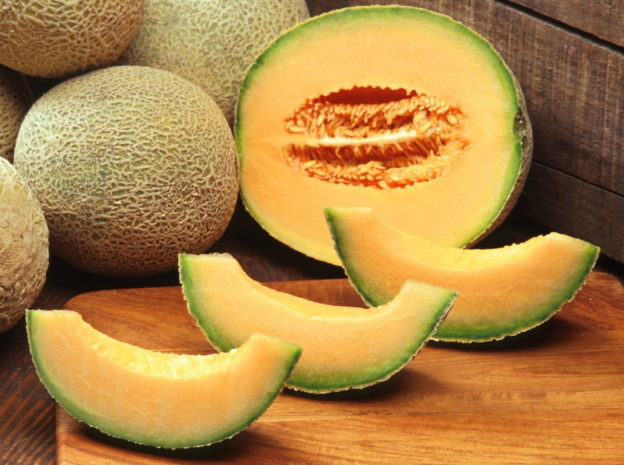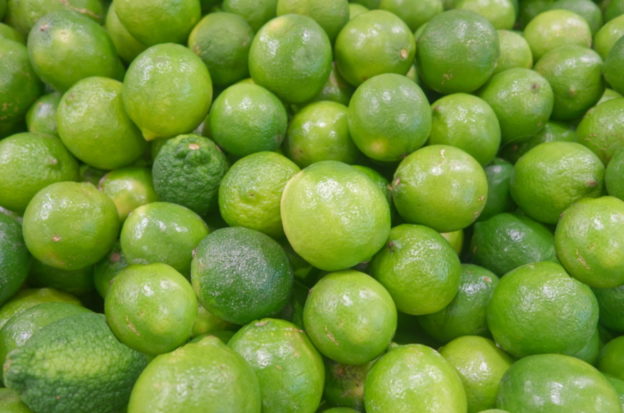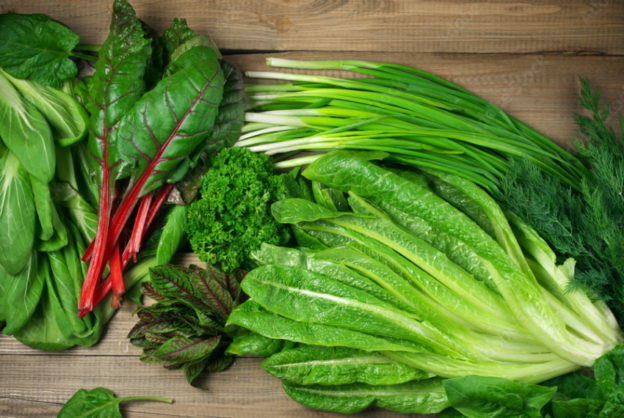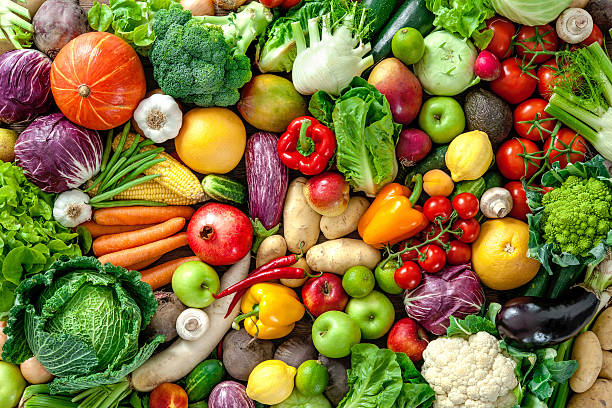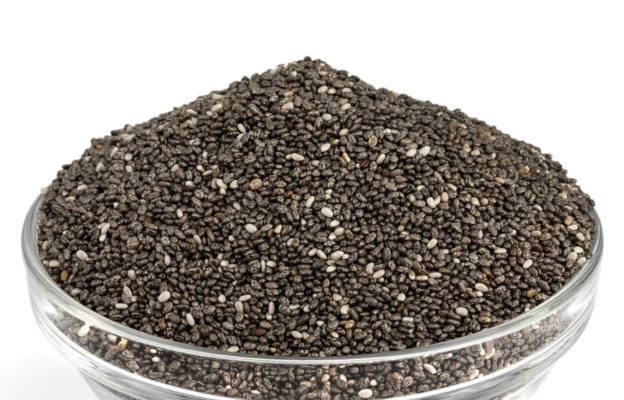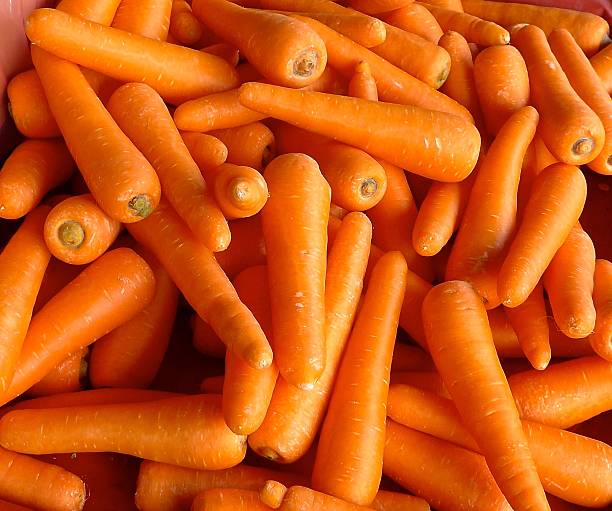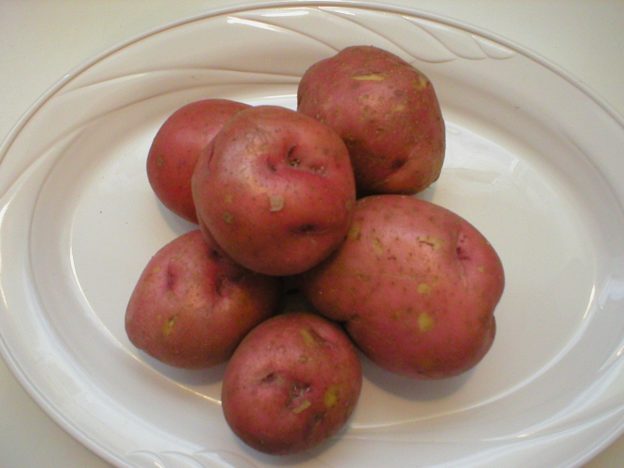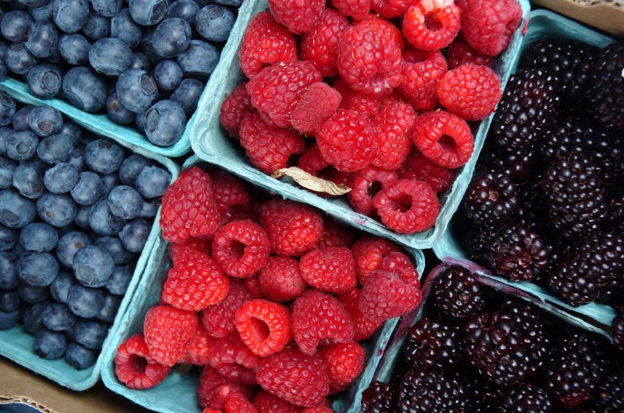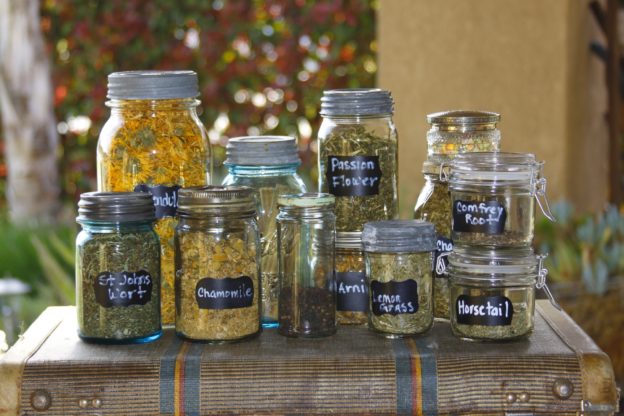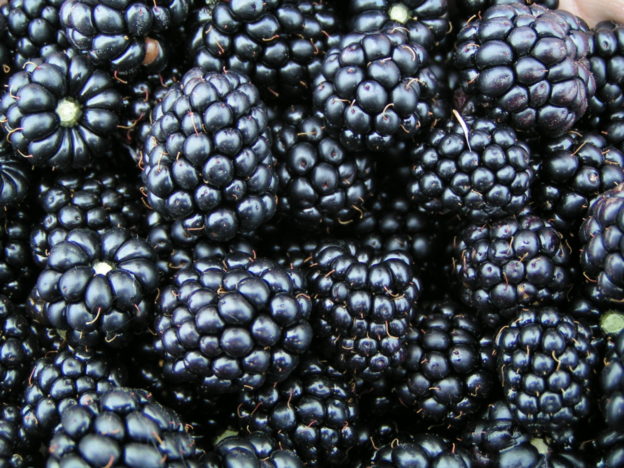Leafy Greens 101 – The Basics
What Are Leafy Greens?
“Leafy greens” is a broad term for plant leaves eaten as a vegetable. There are a variety of flavors and textures of leafy greens and they can belong to different botanical families. Flavors can range from very mild, to nutty, to spicy/peppery, to bitter. Some are tender and sweet, and are usually eaten raw (such as spinach and lettuce), whereas others are tougher and somewhat bitter (such as mustard and collard greens), so they are usually cooked.
The U.S. Department of Agriculture lists over 60 different varieties of leafy green vegetables known to be imported or grown commercially in the United States. There are yet other lesser-known varieties grown in home gardens or gathered in the wild.
Leafy greens have been called “super foods” and people have been eating them for thousands of years. This is for good reason! They’re packed full of vitamins, minerals, fiber, and other compounds that boost our health in many ways. Plus, they’re very low in calories, and can be enjoyed raw or cooked in a variety of ways. What more could we possibly ask for in a food?
Types of Leafy Greens
Collards, mustard greens, kale, chard, broccoli rabe, spinach, bok choy, arugula, beet greens, dandelion greens, lettuce, broccoli, endive, escarole, purslane, radicchio, savoy, sorrel, parsley, and cress are but some examples of leafy greens. Leafy green vegetables and herbs come in many different shapes, sizes, flavors, and even colors or shades of green. Some form tightly bound heads of leaves, while other form loose heads. Others are loose leaf varieties, forming no distinguishable heads at all. Yet, they fall under the broad category of leafy greens. Many, but not all, belong to the Brassica plant family (also known as cruciferous vegetables). What they all have in common is the fact that they are extraordinarily good for us to eat and have important health properties that shouldn’t be ignored.
Sweet Greens. Lettuce is a type of leafy green and is one of the most commonly eaten vegetables in the United States. Different types of lettuce have different colors, ranging from light to dark green, with some even having some red tones on the leaves and stems. Lettuce is usually sweet and mild in flavor.
Bitter Greens. Bitter greens are just that…bitter in flavor. However, the degree of bitterness can vary from variety to variety, and even within the same plant species. For instance, arugula can be mild and somewhat peppery when harvested early in the season. But when harvested later, toward the end of its growing season, it can be extremely strong tasting.
Endive, escarole, and radicchio are under the same plant family umbrella (Asteraceae) as lettuce, but they are actually different types of plants. They are from the chicory family, while lettuce is from the daisy family. Endive, escarole, and radicchio are bitter in flavor and also have more fiber than lettuce, to they are tougher to chew.
Other bitter greens are cool-weather plants, such as collards, kale, turnip greens, mustard greens, and even spinach. These greens are sometimes used in raw applications (especially young spinach leaves), but the mature leaves are often cooked to tame their bitterness. They are usually more tough than lettuce, and they tenderize when cooked.
Nutrition and Health Benefits
Leafy greens are well-known as being nutrient dense foods. This simply means that they supply a LOT of nutrients with few calories. They would be an excellent addition to any “all you can eat” food list. Dark-green leafy vegetables offer a lot of nutritional value with many important health benefits. The darker the leaves, the more nutrient-rich is the vegetable. For instance, romaine lettuce has nine times more Vitamin A than iceberg lettuce.
Since this article focuses on leafy greens in general, it’s not possible to be all-inclusive about the nutritional components of each specific leafy green vegetable. However, even though the components and amounts may vary, they do have some nutritional benefits in common. Overall, they contain plenty of Vitamins A (in the form of beta-carotene), C, E, and K. Many of the dark-green leafy vegetables, such as kale, spinach, romaine lettuce, and collard greens are also rich in B-complex vitamins, especially folate. Greens also contain magnesium, potassium, iron, calcium, fiber, and a wide array of phytonutrients including beta-carotene, lutein, and zeaxanthin, and even some omega-3 fatty acids.
Cancer Prevention. It has long been established that green leafy vegetables are high in compounds that have strong anti-cancer properties. Such compounds include isothiocyanates, carotenoids, and folate. These compounds are particularly high in the Brassica (cruciferous) family of plants, including arugula, broccoli, kale, collards, Brussels sprouts, cabbage, bok choy, turnip greens, and watercress, among others.
Research has shown that eating 2 to 3 servings of green leafy vegetables a week may reduce the risk of stomach, breast, and skin cancers. We also know that leafy greens are high in the B-vitamin folate. Research studies have shown that a high intake of folate may lower the risk of colon polyps by 30 to 40 percent, when compared to low intakes. Some studies also suggest that a low intake of folate may increase the risk of breast, cervix, and lung cancers.
Weight and Blood Sugar Control. Leafy green vegetables are low in calories and carbohydrates, giving them a low glycemic index. This makes them ideal foods to add to a healthy diet, whether you’re trying to lose or maintain your weight. Also, the low glycemic index of leafy green vegetables combined with their high fiber content makes them an ideal food to eat often to help regulate blood sugar and manage diabetes.
Prevention of Neural Tube Defects in Newborns. Neural tube defects are birth defects where the embryo’s central nervous system (the neural tube) fails to close completely before birth. The neural tube forms very early, just one month after conception. This is the structure that will grow into the brain and spinal cord of the infant. In neural tube defects, the seam over the tube does not close correctly, and portions of the spine, the covering of the spinal cord (the meninges), or the cord itself can protrude out of the back of the fetus.
The two most common neural tube defects are spina bifida and tethered cord syndrome. Spina bifida is a malformation of the vertebrae and skin surrounding the spine that can lead to a number of serious health issues. This defect forms very early in embryonic development, merely one month after conception. Most of the time, surgical correction of the defect is needed soon after birth.
Tethered cord syndrome occurs when the spinal cord is abnormally attached to surrounding tissue. Failure to detect this defect can lead to a sudden injury or paralysis during childhood or adolescence. Diagnosis is usually confirmed by an MRI scan and surgery is usually needed to correct the problem.
Research has shown that getting enough folate before conception through early pregnancy can greatly reduce the risk of neural tube defects. Since grain products have been fortified with folic acid, the incidence of such defects has decreased tremendously.
Furthermore, research has found that women who are obese, have poorly controlled diabetes, have been exposed to high temperatures (such as a fever or using a hot tub or sauna) during early pregnancy, or take certain antiseizure medications have a greater risk than other women of having a child born with a neural tube defect.
This example shows how important diet and lifestyle can be not only to adults, but to their potential offspring. Such defects can occur before a woman even knows she is pregnant. Once she learns of her pregnancy and makes needed dietary improvements, the damage may have already been done. So, if you are planning on having a child, it is important to prepare yourself in advance of becoming pregnant. Eat the best foods you possibly can, and be sure to include plenty of leafy green vegetables along the way.
Bone Health. Green leafy vegetables are known to be high in both calcium and Vitamin K. One role of Vitamin K is to work with calcium in helping to build and maintain healthy bones. Without adequate Vitamin K, bones cannot utilize calcium in the bone building process. Eating leafy green vegetables helps to ensure we have adequate nutrients to keep our bones strong. Some research studies have shown that higher Vitamin K intakes are associated with a lower rate of hip fractures and higher bone density. A report from the Nurses’ Health Study suggests that women who get adequate Vitamin K are less likely to break a hip than women who don’t. Eating one serving of leafy green vegetables a day cut the risk of hip fracture in half when compared with eating only one serving a week. Because of their Vitamin K content, dark green leafy vegetables have been shown to help protect bones from osteoporosis.
Heart Health. Vitamin K is also known to help protect the heart from left ventricular hypertrophy (LVH). The left ventricle is the heart’s major pumping chamber. In LVH, the left ventricle is enlarged which causes the heart to be less efficient at pumping blood. This is a condition often looked for in adults; however, it can be found in just about any age group. In a study reported in the October 2017 issue of The Journal of Nutrition, researchers monitored the physical activity routines and diets (with a focus on their Vitamin K intake) of 766 adolescents who were 14 to 18 years of age. They found that those with the lowest Vitamin K intake, had the highest rate of LVH. Subjects with the highest intake of Vitamin K had the lowest rate of LVH. Those who ate 42 mcg or less of Vitamin K per day were over three times more likely to have left ventricular hypertrophy than those who ate 90 mcg or more per day.
Without follow-up investigation it is not possible to say for certain that the dietary habits of the subjects who ate little Vitamin K led to heart disease in their adult years. However, it certainly is a possibility. It is interesting to note that only 25 percent of the teenagers in the study met adequate intakes of Vitamin K in their diet.
Needless to say, the importance of a healthy diet cannot be overestimated, and this stands for people of all ages, not just adults. Without a doubt, we all need to make sure that our entire families eat plenty of leafy green vegetables on a regular basis, if for no other reason than our heart health!
Folate, one of the B-complex vitamins that is abundant in leafy greens, is known to promote heart health. Researchers have found that getting adequate folate on a regular basis can lower our risk for heart disease and stroke by about 20 percent. Folate lowers homocysteine, an amino acid in the blood. A growing body of research suggests that a higher-than-normal level of homocysteine is an independent risk factor for heart disease. It can lead to dangerous blood clots and hardening of the arteries. Getting ample folate in the diet through eating plenty of leafy green vegetables is an easy way to meet your folate needs, reducing your risk for heart disease by keeping homocysteine levels in check.
Eye Health. Lutein and zeaxanthin are two important and very powerful carotenoids that are found in many fruits and vegetables. They often give plants a yellow to reddish hue. Dark green vegetables and herbs such as kale, spinach, parsley, and broccoli are also excellent sources of lutein and zeaxanthin. The yellow pigment of the carotenoids is masked by the chlorophyll in the greens, so don’t let the color fool you. The average diet, which is low in colorful fruits and vegetables, does not contain a lot of these carotenoids.
These two important carotenoids are best known for protecting the eyes from free radical damage. With the eyes constantly being exposed to oxygen and light (during our waking hours), free radicals can easily form. Lutein and zeaxanthin work together to disable free radical molecules before they have a chance to damage our eye cells. In fact, they are the only dietary carotenoids that accumulate in the retina, especially in the macula region, located at the back of the eye. Since the macula is essential for vision, they work together to help prevent macular degeneration, helping to preserve our vision even into old age.
Lutein and zeaxanthin also act as a natural sunscreen by absorbing excess light. They are believed to offer protection of the eyes from excess blue light. This is especially important if we spend a lot of time looking at electronic devices, such as computer screens, cell phones, tablets, and televisions.
Some conditions that lutein and zeaxanthin may help include:
* Age-related macular degeneration (already discussed above)
* Cataracts
* Diabetic retinopathy
* Retinal detachment
* Uveitis. This is an inflammatory condition in the middle layer of the eye that can cause blindness. Lutein and zeaxanthin are believed to help reduce the inflammatory process in this condition.
Considering the average diet is low in colorful fruits and vegetables, especially leafy greens, this information alone should give many people good reason to include more of these special foods into their meals.
Word of Caution. Leafy greens are usually high in Vitamin K which is a blood thickener. If you are taking blood thinning medications, you have probably already been told to limit your intake of Vitamin K-rich foods, such as leafy greens. Therefore, if you want to change your usual diet and increase your intake of any foods that are high in Vitamin K, it is important to consult with your doctor first. Your prothrombin time may need to be monitored and your medication may need to be adjusted.
How to Select Leafy Greens
Choose greens with crisp, brightly colored leaves. They should not be wilted. Avoid those with yellowing leaves or damage.
How to Store Salad Leafy Greens
Packaged Prewashed Salad Greens. If you purchased already washed salad greens in a tub, simply store that in the refrigerator until you are ready to use them. Sometimes droplets of water may form within the tub and under the lid, which causes them to age faster. To help prevent this, it is helpful to place a paper towel on top of the greens in the tub as soon as you bring them home. This will absorb any excess moisture that forms on the inside of the lid, helping to keep the greens from wilting. Be sure to use them before the “Best By” date for optimal freshness.
Whole Heads of Lettuce. Fresh heads of lettuce may be stored in a couple different ways. If you prefer to store them unwashed, simply wrap your new head of lettuce in a clean cloth. Drizzle the cloth with no more than ¼ cup of water, and place the wrapped head in a plastic bag to keep the lettuce from drying out. Store it in the refrigerator (crisper drawer, if possible) until you are ready to use it. For optimal freshness, use it as soon as possible, preferably within 7 to 10 days (at most).
If you prefer to wash your lettuce in advance, tear the lettuce into the size pieces you intend to use later. Rinse and spin them dry in a salad spinner. Transfer them to an airtight container and store them in the refrigerator for up to a week (10 days at most). It is helpful to line the container with a clean cloth or paper towels to absorb any excess water that may be on the leaves, preventing them from rotting. The towels will retain the moisture, creating a humid environment that will help to keep the leaves crisp.
How to Store Bitter Leafy Greens
Remove any discolored, wilted, or damaged leaves before storing your greens. It’s easiest to keep your greens whole and unwashed until you need them by simply removing any twist ties holding them together, and wrapping the loose leaves in a clean cloth. Drizzling the cloth with no more than ¼ cup of water. Place the wrapped leaves in a plastic bag and store it in the refrigerator.
To prewash your greens before storing them, rinse them well with water, shake off excess water, then lay them out on paper towels or a clean cloth, and roll them up. Do not drizzle the towel with water since the leaves will already have water on them. Place the wrapped leaves in a plastic bag and store them in the refrigerator. Try to use them within 3 to 5 days.
How to Prepare Salad Leafy Greens
Salad Greens. If you did not wash your salad greens before storing them, simply give them a quick rinse, then spin them dry in a salad spinner, shake off excess water in a colander, or pat them dry on a layer of clean cloth or paper towels. Serve as desired.
Packaged Prewashed Salad Greens. Despite the fact that they have been prewashed, it is advisable to give them a quick rinse right before you use them. Spin them dry in a salad spinner, shake excess water off of them in a colander, or lay them on a clean cloth or paper towels and blot them to remove excess water. Remove and discard any discolored or wilted, soggy leaves. Serve as desired.
Prewashed Heads of Lettuce. If you prewashed your head of lettuce when you brought it home, and stored it as detailed earlier, you should be able to use it straight from your container. If preferred, you may wash it again, then use it as desired.
How to Prepare Bitter Leafy Greens
Rinse your greens well and shake off excess water. Cut off (and discard) a small portion of the bottom end of the stems (unless you are removing the stems and not using them at all). If your greens are a little wilted, trim off a small portion of the bottom end of the stem and stand them upright in a bowl or pitcher of water and allow them to rest there until revived. About an hour may be enough time to refresh the greens. Then cut them as desired and prepare as planned.
How to Freeze Bitter Leafy Greens
Freezing leafy greens is an excellent way to preserve extras that you have on hand. It makes them quick and easy to cook, with all the prep work having been done in advance. There is a current movement to freeze vegetables without blanching them. This can be done, but if you want to preserve your foods for the longest time with the best quality possible, blanching them is something that must be done. It’s not hard and really does not take much time. The effort is well worth it in the long run. Here are the steps:
- Wash your greens well and chop them into desired size pieces. Strip away the stems, if desired. If you want the stems, leave them attached, but trim off a small portion of the bottom end of each stem. With leafy greens, cutting them into smaller pieces before freezing is usually best because they will be the easiest to cook and eat later.
- Bring a large pot of water to boil. Do not add salt to the water. Have a timer handy.
- When the water is boiling, transfer your prepared greens into the water. Immediately set your timer for 1 minute. Meanwhile, get a large bowl of ice water ready.
- As soon as the timer is finished, transfer the greens to the ice water bath. Allow them to chill for at least 1 minute.
- Transfer the chilled greens to a colander and allow them to drain well. Squeeze them if you want to remove any excess water. (This step is helpful, but not mandatory.)
- Transfer your drained greens to a freezer bag or airtight container. Remove as much air from the bag or container as possible, and place them in the freezer. If you want to avoid having your greens freeze into one big lump, first lay them out in a single layer on a baking sheet or tray. Place the tray in the freezer until the greens are completely frozen. Then transfer the frozen greens to your freezer bag or container, and return them to the freezer. Be sure to label the container with the contents and date they were frozen. Use them within 1 year.
For best results, your frozen greens will need to be cooked in some way when it’s time to use them. It is not mandatory, but they can be thawed first, if preferred. They can be placed in the refrigerator overnight, placed on the kitchen counter for an hour or two at the most, or placed in a colander and thawed under running water.
Quick Ideas and Tips for Using Leafy Greens
There are many ways to include leafy greens in your diet. Here are some examples:
* Use salad or bitter leafy greens as a foundation for a meal, as often as you can. Add assorted vegetables, fruits, grains, and proteins of your choice.
* Include a lot of leafy greens such as spinach, arugula, lettuce, cabbage, or Swiss chard as a filling for a wrap.
* Add greens to soups. Bok choy, cabbage, Swiss chard, kale, spinach, or Asian greens would all add color, nutrition, and flavor to just about any soup.
* Try adding chopped greens to your favorite pizza.
* Add chopped greens to sautés and stir-fries.
* Use leafy greens when making pesto.
* If you juice fresh fruits and vegetables, don’t forget to add fresh leafy greens! Spinach, kale, Swiss chard, Spring mix, or even romaine lettuce would all work well.
* Don’t forget to add leafy greens to a sandwich. Lettuce, arugula, Spring mix, baby greens, and spinach would all work well.
* Leafy greens can be chopped finely and added to sauces. Adding greens to a marinara sauce would add texture, flavor, nutrition, and color.
* Greens can add extra flavor, color, and nutrition to any meal. Try grilling, steaming, boiling, braising, and even stewing them. Some greens, like Spring mix, baby greens, or spinach would work well as a raw adornment to many dishes.
* Add greens to smoothies. Spinach, Spring mix, baby greens, and lettuce are all tender, mild flavored greens that would work well in just about any smoothie mixture.
* Some leafy greens, such as collard greens, spinach, and chard are high in Vitamin K. If you are on blood thinning medication, it’s important to talk with your doctor before increasing your intake of Vitamin K-rich foods. Your prothrombin time may need to be monitored, and your medication dosage may need to be adjusted.
* If you eat eggs, try adding some chopped leafy greens like spinach, to an omelet or scrambled eggs.
* Try roasted radicchio drizzled with a little balsamic vinegar.
* Grill wedges of radicchio and serve as a side dish.
* Try adding a little radicchio to a stir-fry.
* Add radicchio to soups, stews, and pasta dishes.
* It’s helpful to remember that some greens cook faster (like spinach) than others (like kale or collards). So, if you intend to combine them on one dish, add the more tender greens that cook faster toward the end of cooking, to avoid overcooking them.
* Chop greens into bite-size pieces and add to soups and stews.
* Try a wrap packed with your favorite salad greens, bell pepper, and your favorite hummus.
* Keep green salads interesting by combining different types of leafy greens. Different types of lettuce, Spring mix, radicchio, cabbage, spinach, Asian greens, arugula, chard and baby mixed greens, all go well together in a mixed green salad. Different greens can be tender or crispy, slightly bitter or sweet, and vary in color, texture and nutritional value. All of that can add to flavor and visual appeal of your salad. Enjoy a large salad every day!
Herbs and Spices That Go Well with Leafy SALAD Greens
Anise seeds, basil, capers, cayenne, chervil, chili pepper flakes, cilantro, dill, garlic, ginger, lovage, marjoram, mint, mustard, parsley, pepper, salt, tarragon, thyme
Foods That Go Well with Leafy SALAD Greens
Proteins, Legumes, Nuts, Seeds: Almonds, bacon, beans (in general), beef, black beans, chicken, chickpeas, eggs, ham, hazelnuts, lamb, lentils, nuts (in general), peanuts, peas, pecans, pine nuts, pistachios, pork, pumpkin seeds, sesame seeds, sugar snap peas, sunflower seeds, tahini, tofu, tuna (and other seafood), turkey, walnuts
Vegetables: Beets, bell peppers, carrots, cauliflower, celery, celery root, chayote, chiles and chili paste, chives, cucumbers, fennel, jicama, leeks, mushrooms, nori, onions, parsnips, potatoes, radicchio, radishes, scallions, shallots, sprouts, tomatoes, watercress
Fruits: Apples, apricots (esp. dried), avocados, blackberries, blueberries, cranberries (dried), figs, grapefruit, grapes, lemon, limes, mangoes, olives, oranges, pears, persimmons, pomegranate seeds, raspberries, raisins, strawberries, tangerines
Grains and Grain Products: Bulgur, corn, corn chips, corn tortillas, croutons, quinoa, rice
Dairy and Non-Dairy: Buttermilk, cheese (in general, esp. asiago, blue, cheddar, feta, goat, Gorgonzola, mozzarella, Parmesan), crème fraiche, yogurt
Other Foods: Honey, mayonnaise, miso, mustard (prepared), oil (esp. flaxseed, grapeseed, olive, sesame), soy sauce, tamari, Worcestershire sauce, vinegar (esp. balsamic, champagne, cider, red wine, rice wine, sherry, tarragon, white wine), vinaigrette dressings
Leafy SALAD greens have been used in the following cuisines and dishes…
Lettuce wraps, salads (i.e., grain, green, potato), sandwiches, burgers (of all types)
Suggested Food and Flavor Combos Using Leafy SALAD Greens
Add leafy salad greens to any of the following combinations…
Almonds + Avocado + Carrots + Tomatoes
Almonds + Citrus + Fennel
Almonds + Jicama + Orange
Apples + Celery + Hazelnuts
Apples + Celery + Lime + Raisins + Walnuts
Apples + Clementines + Endive + Walnuts
Avocado + Cilantro
Avocado + Grapefruit + Pecans + Radicchio
Avocado + Lime
Balsamic Vinegar + Garlic + Mustard + Olive Oil
Beets + Celery
Blue Cheese + Pears + Walnuts
Carrots + Cucumbers + Dill + Feta Cheese
Chickpeas + Cucumbers + Feta Cheese + Olives + Red Onions + Tomatoes
Chiles + Orange + Pecans
Dill + Garlic + Lemon + Scallions
Dill + Olive Oil + Red Wine Vinegar + Scallions
Dijon Mustard + Lemon + Olive Oil + Scallions
Fennel + Grapefruit
Feta Cheese + Tomatoes
Figs + Goat Cheese + Tarragon
Goat Cheese + Pecans
Goat Cheese + Strawberries
Gorgonzola Cheese + Hazelnuts + Lemon + Olives
Lemon + Parmesan Cheese
Lentils + Rice
Pears + Sherry Vinegar + Walnuts
Herbs and Spices That Go Well with Leafy BITTER and OTHER Greens
Allspice, basil, bay leaf, capers, cardamom, cayenne, chili pepper flakes, chili powder, cinnamon, cloves, coriander, cumin, curry powder, curry spices, dill, garlic, ginger, mustard, nutmeg, oregano, paprika, parsley, pepper, sage, salt, tarragon, thyme, turmeric
Foods That Go Well with Leafy BITTER and OTHER Greens
Proteins, Legumes, Nuts, Seeds: Bacon, beans (in general), beef, black-eyed peas, cashews, chicken, chickpeas, eggs, ham, lentils, peanuts, pecans, pine nuts, pork, salmon (seafood, in general), sausage, sesame seeds, shrimp, sunflower seeds, tofu, turkey, walnuts
Vegetables: Chiles, chives, fennel, mushrooms, onions, parsnips, potatoes, radishes, sweet potatoes, tomatoes, turnips
Fruits: Apples, avocado, coconut, lemons, limes, olives, oranges
Grains and Grain Products: Barley, bread crumbs, corn, cornbread, grains (in general), millet, noodles (esp. Asian), pasta, quinoa, rice
Dairy and Non-Dairy: Butter, cheese (i.e., Parmesan, pecorino), coconut milk, cream
Other Foods: Miso, mustard, oil (esp. olive, sesame), soy sauce, stock, tamari, vinegar (esp. apple cider), wine (dry white)
Leafy BITTER and OTHER greens have been used in the following cuisines and dishes…
African cuisines, Asian cuisines, Chinese cuisine, Indian cuisine, Japanese cuisine, pasta dishes, salads, soups (esp. bean, potato, root vegetable), Southeast Asian cuisines, Southern (U.S.) cuisine, stews, stir-fries, tofu scrambles
Suggested Food and Flavor Combos Using Leafy BITTER and OTHER Greens
Add leafy bitter and other greens to any of the following combinations…
Apple Cider Vinegar + Black-Eyed Peas
Apple Cider Vinegar + Chili Flakes + Garlic
Chiles + Garlic + Lemon + Olive Oil
Garlic + Ginger + Soy Sauce
Garlic + Lemon
Garlic + Lemon + Olive Oil + Onions
Garlic + Olive Oil + Tamari
Garlic + Tomatoes
Lemon Juice + Olive Oil + Rice
Onions + Tomatoes
Pasta + White Beans
Scallions + Sesame Oil + Tamari
Tomatoes + Zucchini
About the Different Types of Leafy Greens
Head varieties of greens form more tightly formed heads than the leaf varieties of greens. This list is not all-inclusive, but covers many types of greens that may be found in stores in the United States.
Bok Choy
Bok choy is a member of the Brassica family of plants. It is also known as Chinese cabbage, pok choi, and other names in various cultures around the world. The flavor of bok choy is very mellow with a mild, peppery spice. The flavor is similar to cabbage. Bok choy leaves are tender yet crisp. The stalks are crunchy, firm and juicy. Depending on the variety, the leaves may be dark green or yellow-green, and the stalks may be yellow-green or off-white. Bok choy may be found in mature and “baby” sizes. Both are tender, but the baby variety is more so, and is often cooked whole. Bok choy is excellent when stir-fried, braised, steamed, sautéed, or added to soups. The leaves may be eaten raw in salads. Bok choy is usually found in most American grocery stores and should also be available in most Asian markets. One outstanding nutritional feature of bok choy is that it contains selenium, a mineral that helps cognitive function, thyroid function, metabolism, immunity, and possibly cancer prevention.
Brussels Sprouts
Brussels sprouts are members of the Brassica plant family. They have compact, small heads with tightly bound leaves, and are usually one to two inches in diameter when mature. They are similar in flavor to cabbage, but can be somewhat bitter, depending on the cooking method. Younger Brussels sprouts are sweeter than larger, more mature ones.
Brussels sprouts may be eaten raw when grated or shaved finely. More often they are cooked. However, they taste their best when not boiled, as boiling brings out their sulfurous, bitter flavor more than any other cooking method. Roasting, quick braising, or pan frying in oil or butter are better methods of cooking Brussels sprouts for the best flavor. Their flavor is complimented well with garlic, shallots, thyme, rosemary, and sage. They can be added to casseroles, gratins, and roasted vegetable medleys. They pair well with bacon, pork, cheese, cream, eggs, ham, grapefruit, olive oil, apple cider vinegar, lemon, hollandaise sauce, maple syrup, mushrooms, mustard, nutmeg, pepper, pistachios, and pancetta.
Cabbage
Cabbage is a member of the Brassica plant family, so it is related to Brussels sprouts, broccoli, and kale, among other greens. The heads can grow in green, white, or purple colors. Cabbage can have a somewhat bitter flavor when raw, but mellows when cooked. Cabbage is often sautéed or added to soups and stir-fries. It can also be stuffed or made into cabbage rolls. Many cultures ferment cabbage into sauerkraut or kimchi. Cabbage offers a lot of Vitamin K, Vitamin C, folate, manganese and many antioxidants. Cabbage, like other members of the Brassica plant family contain properties that have been shown to help prevent various forms of cancer.
Endive
Endive is a member of the Cichorium plant family. This same family also includes dandelions and sunflowers. It is sometimes marketed as Belgium endive or frisée. The flavor of endive is nutty and mellow. It is usually added to salad with other mixed greens. Belgium endive is most often roasted or grilled with balsamic vinegar and olive oil, which brings out its nutty flavor. Endive is a good source of Vitamins A and K, along with folate and kaempferol, an antioxidant that is known for reducing inflammation.
Escarole
Escarole has dark, thick leaves that are bunched up together, making it look like a head of lettuce. Lighter leaves have a sweet flavor, while the darker leaves are more bitter. When used raw in salads and sandwiches, escarole adds a strong flavor to the dishes it’s included in. The strong flavor mellows when the leaves are cooked. They are often sautéed or added to soups. Escarole contains a lot of Vitamins A and C, calcium, iron, and fiber.
Lettuce (Romaine)
Romaine lettuce is a popular variety of lettuce that has large, dark green leaves with firm ribs attached to a base. This variety of lettuce is crisp and mild in flavor. It is usually the main ingredient in Caesar salad. However, romaine lettuce may be used in any type of salad, lettuce wraps, or sandwiches as desired. Most of the nutrients in romaine lettuce are found in the dark, thick leaves. They are especially high in Vitamins A and K.
Napa Cabbage (Chinese Cabbage)
Napa cabbage is a member of the Brassica family of plants. It has many names that vary from country to country. The flavor is delicate, mild and a bit sweeter than green cabbage. It is watery yet firm and crunchy with thick stalks. The leaves are thinner and more delicate than those of green cabbage. They are tender and juicy when cooked. Napa cabbage is best when cooked in stir-fries and soups. It can be shredded and included in salads, slaws, and wraps. Napa cabbage is often used in making kimchi, and as a filling for Chinese dumplings.
Radicchio
Radicchio is a bitter vegetable that is often mistaken for a colorful variety of lettuce or cabbage. It is actually a type of chicory, and is often called Italian chicory because it is used a lot in Italian cuisine. Radicchio forms a round or elongated head with deep reddish-purple leaves with white veins. It may be eaten raw in salads or slaws, for a distinct spicy bitterness. When eaten raw, radicchio is often paired with something sweet or acidic to balance the flavors. Cooking mellows the bitterness of radicchio, and actually sweetens it some. Radicchio roasts, sautés, and grills up well, and can also be slow-cooked and combined with other vegetables and/or meat. Radicchio is particularly high in Vitamin K, which helps with cognition, and heart and bone health. It is also high in antioxidants, helping to protect us from oxidative stress. It also contains good amounts of other nutrients, including Vitamins C and B6, magnesium, calcium, zinc, iron, potassium, and selenium, among others.
Leaf varieties of greens form loose heads or individual leaves. This list is not all-inclusive, but covers many types of greens that may be found in stores in the United States.
Arugula
Arugula is sometimes called “rocket.” It is a member of the Brassica plant family. The flavor of arugula is peppery. This characteristic makes it a green that is often added raw to salads and pizza for added flavor. Arugula can also be sautéed and added to pasta dishes and soups for an added flavor dimension. Arugula is high in dietary nitrates, carotenoids, Vitamin K, and folate.
Beet Greens
Like turnip greens, beet greens are often discarded. But they are edible and can be used just like spinach. They can add some wonderful flavor and interesting color to any dish. The flavor of beet greens is earthy, much like their bulbs. They are very tender, so they can easily be enjoyed raw in salads, and they pair well with a lemon-based or vinaigrette dressing. When beet greens are sautéed or steamed, the dark red color in the stalks remains intact, which makes them a colorful addition to any plate. They make great additions to soups and side dishes. Beet greens are rich in potassium, fiber, beta-carotene, and lutein. They also contain a lot of calcium, and Vitamins A and K.
Broccoli
The broccoli crown (floret) that we typically see in the grocery store may not appear to be a “leafy” green vegetable. But in actuality, the crowns we buy are the flowering heads of the leafy green broccoli plant that is maturing and about to produce seeds. So, the broccoli plant itself is a leafy green vegetable. It would be a very rare occasion (if at all) to find broccoli leaves in your local market. In fact, just about the only way to access broccoli leaves would be for you to grow the plant yourself. The leaves are perfectly edible and are quite delicious. They are mild and not overly bitter, like many similar leafy greens. They may be prepared like any bitter green such as kale, collards, or turnip greens.
In a study published in the April 2018 issue of the journal Molecules, researchers compared a nutritional analysis of broccoli crowns, stems, and leaves. The crowns had higher concentrations of amino acids and glucoraphanin (the precursor to sulforaphane, a compound with strong health benefits) when compared with the other tissues. The leaves were higher in carotenoids, chlorophylls, Vitamins E and K, total phenolic content, and antioxidant activity. The leaves were also good sources of calcium and manganese when compared with the stem and florets of the plant. So, if you grow your own broccoli, don’t toss out the leaves! Enjoy them as you would any leafy green vegetable. If you don’t grow broccoli, enjoy broccoli florets on a regular basis.
Broccoli Rabe
Despite its name, broccoli rabe is actually part of the turnip family of plants. It is often called turnip broccoli, rapini, Italian turnip, broccoli rabe, and broccoletti di rapa. The flavor of broccoli rabe is bitter, so it is usually cooked which mellows the flavor. It may be sautéed, blanched, boiled, or steamed. It is often sautéed with garlic and onion, and topped with Parmesan cheese. Broccoli rabe is high in potassium, fiber, and pantothenic acid.
Chard
There are many varieties of chard plants, but all have dark leaves with a long stalk in the center. The stalks can be a variety of colors, and marketed as rainbow, red, yellow, or white chard. It may also be referred to as leaf beet, sea kale, or silver beet. Chard has a mellow, earthy flavor, with stalks that are slightly sweet. It is commonly used in Mediterranean cuisine. The stalks take longer to cook than the leaves, so they are often separated so they can be cooked for appropriate times. Chard is often sautéed or steamed then added to soups, casseroles, or even tacos. Chard can be eaten raw, but the leaves can be tough. The stems can provide a crunchy snack. Swiss chard is high in Vitamins A, K, and C, along with potassium, and manganese.
Collard Greens
Collard greens are also known as collards, borekale, and tree cabbage. The plant has thick, dark green leaves that are packed with nutrients. The flavor of their rather tough leaves is slightly bitter, so although they can be eaten raw, they are most often cooked to tenderize them and remove the bitterness. Collard greens are often braised or steamed and served with pork. They can also be added to stir-fries, slaws, and even sandwiches. Collard greens are exceptionally high in Vitamin K.
Dandelion Greens
Even though we consider them to be weeds in the lawn, all parts of the dandelion plant are edible: the flower, roots, and stem. If you elect to pick them out of your yard to eat, be sure they have not been tainted with pesticides, even from a neighbor’s yard. The flavor of dandelion greens is earthy and somewhat nutty. The greens may be eaten raw in salads and sandwiches. They may also be sautéed and added to casseroles. Some chefs use dandelion greens in place of spinach to add a unique touch to pasta dishes. Interestingly, the nutritional value of dandelion greens remains even after being cooked. They are full of Vitamins E, A, and C, and folate. They also contain a substantial amount of calcium, iron, and magnesium.
Kale
There are different varieties of kale that vary in shape, color, and degree of tenderness. Kale is typically dark green with a strong stem in the middle with leaves that are curly at the ends. Kale is slightly bitter when eaten raw, but mellows when cooked. It is often sautéed, added to soups, and roasted as kale chips. Kale may also be eaten raw in salads. Younger, baby kale leaves would be more tender and easier to eat in a salad. To get the most nutritional value out of kale, eat it raw, or drink freshly made kale juice. Kale is exceptionally high in Vitamins A, K, B6, and C, calcium, potassium, copper, and manganese.
Kohlrabi Greens
Kohlrabi is a member of the Brassica plant family. Kohlrabi greens are simply the long stalks with leaves attached that grow upward from kohlrabi bulbs. The stalk matches the color of the kohlrabi bulb, which can be white or purple. The flavor of the greens is mild and sweet, similar to broccoli. The leaves and stalks of kohlrabi are usually cooked, and can easily be sautéed with garlic in oil, like any leafy green. Kohlrabi greens are packed with antioxidants that are known to help prevent cancer and heart disease. They are an excellent source of fiber, potassium, and Vitamins C and B6.
Mustard Greens
There are different varieties of mustard, but all have a peppery, spicy flavor. They are a staple in Southern USA cooking and are often cooked until soft and served with ham. The longer they are cooked, the less spicy is their flavor. Adding a little lemon juice or vinegar at the end of cooking helps to tame the flavor. Mustard greens are often used to make zesty mustard sauces. The seeds are used to make the condiment we know as prepared mustard. Mustard greens are a good source of calcium, folate, magnesium, and Vitamin K.
Pak Choi
Pak choi is a member of the Brassica family. It is a non-heading Chinese cabbage with many varieties that are also known as Bok choy, Bok choi, and Bai cai among other names. It is considered to be one of the oldest cultivated vegetables in the world and is commonly used in Asian cuisine. It is used in both hot and cold dishes.
Pak choi has oval-shaped leaves with curved, thick stems loosely clustered to a bulbous base. The stems can range in color from white to pale green and are crunchy with a slightly fibrous texture. Both the leaves and stems are edible. When eaten raw, Pak choi has a sweet, mustard-like flavor. When cooked, it becomes more tender and the flavor mellows to being similar to cabbage and spinach. Pak choi is an excellent source of Vitamins A and C, along with Vitamins B6, K, and E, magnesium, potassium, iron, manganese, and calcium.
Pak choi is excellent for raw uses, such as in salads and slaws. It is also excellent in cooked applications, such as steaming, boiling, grilling, braising, and sautéing. After being cooked, it is often topped with a sauce, or included in soups, noodle dishes, stir-fries, or served as an accompaniment to meats. It may also be pickled for preservation and extended use. It is sometimes mixed into pasta dishes, added to gnocchi, and served in grain bowls. Pak choi pairs well with mushrooms, carrots, bell peppers, garlic, ginger, citrus, tofu, fish, pork, duck, and other poultry.
Radish Greens
Radish greens are often discarded, but they are completely edible. They have a similar peppery flavor and texture profile as turnip greens. However, radish greens are not usually eaten raw because the leaves can be prickly. Nevertheless, they can be pureed into a zesty pesto. Cooked radish greens are versatile. They can be roasted as a spicy side dish, or added to stir-fries. They can also be added to creamy soups and quiches. Radish greens are high in fiber and iron, making them a green to consider when fighting anemia. They also contain Vitamins A, C, and K, along with antioxidants.
Sorrel
Sorrel is sometimes referred to as sour grass, spinach dock, or sour dock. It has narrow, spade-like leaves that can sometimes be confused with mature spinach. The flavor is tart and acidic. Sorrel is popular in Europe and Central Asia, and can be hard to find in the United States. It can be eaten raw and is often served in salad blends with mixed greens. Sorrel can be added to soups and stews. When cooked, sorrel takes on a lemony flavor that goes well with fish.
Spinach
Spinach has dark-green, rounded leaves. It is a very versatile and often used leafy green, so it should be available in most grocery stores. The mild flavor of spinach allows it to complement many dishes. It can be eaten raw in a salad or sandwich, or cooked in side-dishes and entrées. Spinach may be added to omelets, phyllo pastry, pasta dishes, and even smoothies. It is important to know that the volume of spinach dwindles down dramatically when it is cooked, which means you should probably use more than you think you should when cooking spinach. Spinach is packed with nutrients and is one of the most protein-rich green vegetables. It is also rich in folate, which is critical in red blood cell production, and also helps in proper fetal development during pregnancy.
Tatsoi. Tatsoi is a member of the Brassica family of plants. It is also known as spinach mustard, spoon mustard, rosette bok choy, and Japanese spinach. It has a slightly bitter flavor, like mustard greens, but milder. It has thick, dark green leaves with crisp, juicy stalks. Tatsoi is best cooked, when added to soups, stir-fries, or simply sautéed. Baby tatsoi can be served raw in salads. In the United States, Tatsoi may not be found at most grocery stores; however, Asian markets may carry it.
Turnip Greens
Like many leafy vegetables, turnips are in the Brassica plant family. The greens are simply the leafy tops that grow upward from turnips. The greens have a slightly peppery flavor and are often cooked in a similar way as collard greens. They can be braised or sautéed and served with ham shanks and potatoes. They are sometimes prepared in a slow cooker into a rich and spicy soup. Turnip greens are almost always cooked. They have a prickly texture which makes them undesirable for eating raw. Turnip greens are more nutritious than turnip bulbs. They are packed with antioxidants, calcium, manganese, and Vitamins A, C, and K.
Watercress
Watercress is an aquatic plant that has small, rounded leaves. Like many of the foods discussed in this article, watercress is also a member of the Brassica plant family. The flavor of watercress is similar to that of arugula and mustard greens. It tastes slightly spicy and bitter. Watercress may be eaten raw or cooked. It is often sautéed or cooked as a side dish or added to soups. It supplies a lot of Vitamin K and antioxidants and has been used for its medicinal properties for centuries. Watercress is often used in herbal medicine around the world.
Recipe Links
50 Ways to Get More Leafy Greens in Your Life https://www.tasteofhome.com/collection/ways-to-get-more-leafy-greens-in-your-life/
79 Green Vegetable Recipes for Soups, Salads, Sautés, and More https://www.epicurious.com/ingredients/best-green-vegetable-recipes-gallery
19 New Ways to Eat Leafy Greens https://www.cookinglight.com/food/in-season/leafy-greens-recipes
13 Leafy Green Dinners That Go Beyond Kale https://www.brit.co/living/healthy-eating/leafy-green-dinners-recipes/
Creative Vegetarian Recipes That Make Leafy Greens the Star of Your Plate https://www.shape.com/healthy-eating/meal-ideas/sayonara-salad-17-creative-vegetarian-recipes-using-leafy-greens
Basic Sautéed Leafy Greens https://bostonorganics.grubmarket.com/recipes/chard/basic-sauteed-leafy-greens
Tortellini, White Bean, and Turnip Greens Soup Recipe https://www.southernliving.com/recipes/tortellini-white-bean-and-turnip-greens-soup-recipe
Roasted Baby Turnips with Turnip Green Pesto https://www.southernliving.com/recipes/roasted-baby-turnips-recipe
Turnip Green Salad Recipe https://www.southernliving.com/recipes/turnip-green-salad-recipe
Turnip Greens Soup https://www.yummly.com/recipe/Turnip-Greens-Soup-996412
Roasted Butternut Squash Kale Salad https://rainbowplantlife.com/roasted-butternut-squash-and-cabbage-salad/
Vegan Chickpea Quinoa Arugula Salad with Lemon Garlic Dressing https://shortgirltallorder.com/chickpea-quinoa-arugula-salad#
Japanese Spinach Salad with Sesame Dressing https://okonomikitchen.com/spinach-gomaae/
Vegan Cobb Salad https://www.eatingbirdfood.com/vegan-cobb-salad/#wprm-recipe-container-35408
The Ultimate Fall Salad https://www.makingthymeforhealth.com/the-ultimate-fall-salad/
Kale Citrus Salad https://minimalistbaker.com/kale-citrus-salad/
Thanksgiving Kale Salad with Maple-Tahini Dressing https://www.eatingbyelaine.com/thanksgiving-kale-salad-with-maple-lemon-tahini-dressing/
Vegan Kale Salad with Almond Butter Dressing https://thevegan8.com/garlic-lemon-kale-salad#wprm-recipe-container-34252
Kale and Zucchini Salad with Roasted Parsnip Chips https://thekoreanvegan.com/kale-and-zucchini-salad-with-roasted-parsnip-chips/
Arugula Salad with Peaches https://lifemadesweeter.com/arugula-salad-red-cabbage-pomegranate-orange-pineapples/#wprm-recipe-container-30804
38 Amazing Broccoli Recipes Even Broccoli Haters Can’t Hate https://www.delish.com/cooking/nutrition/g241/broccoli-recipes/
Caramelized Broccoli with Garlic https://www.foodandwine.com/recipes/caramelized-broccoli-garlic
Our Very Best Broccoli Recipes https://www.foodnetwork.com/recipes/photos/broccoli-recipes
Roasted Broccoli https://www.loveandlemons.com/roasted-broccoli/
50 of the Best Broccoli Recipes We’ve Ever Tasted https://www.tasteofhome.com/collection/superstar-broccoli-recipes-even-picky-eaters-will-love/
Garlic Parmesan Roasted Broccoli https://damndelicious.net/2014/09/19/garlic-parmesan-roasted-broccoli/
Sautéed Broccoli https://www.loveandlemons.com/sauteed-broccoli/#wprm-recipe-container-52652
Resources
https://www.webmd.com/food-recipes/ss/slideshow-know-your-leafy-greens
https://www.ars.usda.gov/plains-area/gfnd/gfhnrc/docs/news-2013/dark-green-leafy-vegetables/
https://www.medicalnewstoday.com/articles/green-leafy-vegetables#how-to-add-to-the-diet
https://www.seriouseats.com/asian-green-guide#toc-tatsoi
https://www.webstaurantstore.com/article/526/types-of-greens.html#top
https://eatfresh.org/discover-foods/leafy-greens
https://www.thespruceeats.com/all-about-radicchio-radicchio-rosso-3955258
https://www.webmd.com/diet/health-benefits-radicchio#2
https://specialtyproduce.com/produce/Pac_Choi_13230.php
https://www.hsph.harvard.edu/nutritionsource/vitamin-k/
https://www.ncbi.nlm.nih.gov/pmc/articles/PMC4566462/
https://www.medicalnewstoday.com/articles/319645#Low-vitamin-K-1-intake-correlates-with-LVH
https://academic.oup.com/jn/article/147/10/1960/4727995
https://www.webmd.com/heart-disease/news/20021122/folic-acid-for-your-heart
https://www.nichd.nih.gov/health/topics/ntds/conditioninfo/causes
https://www.hopkinsmedicine.org/health/conditions-and-diseases/neural-tube-defects
https://www.eatright.org/food/nutrition/healthy-eating/different-kinds-of-lettuces-and-greens
https://www.healthline.com/nutrition/lutein-and-zeaxanthin
https://nevegetable.org/crops/lettuce-endive-and-escarole
https://foodiosity.com/endive-vs-lettuce/
https://www.sunriseseniorliving.com/blog/january-2016/foods-to-try-that-are-high-in-folate.aspx
https://livinghealthworks.com/leafy-greens-to-prevent-and-fight-cancer/
https://www.thespruceeats.com/blanching-and-freezing-leafy-greens-1327683
https://foodsguy.com/freeze-greens-without-blanching/
https://specialtyproduce.com/produce/Brussels_Sprouts_1413.php
https://www.eatthis.com/side-effect-eating-leafy-greens/
https://www.sciencedirect.com/topics/agricultural-and-biological-sciences/glucoraphanin
https://www.ncbi.nlm.nih.gov/pmc/articles/PMC6017511/
https://www.mayoclinichealthsystem.org/hometown-health/speaking-of-health/the-many-types-and-health-benefits-of-kale
https://www.ncbi.nlm.nih.gov/pmc/articles/PMC3708350/
https://www.hindawi.com/journals/joph/2015/523027/
https://kerrinboothnaturopath.com/2018/05/11/macular-degeneration-and-retinal-detachment/
Joachim, David. (2010) The Food Substitutions Bible. 2nd Edition. Toronto, Ontario, Canada: Robert Rose, Inc.
Page, Karen. (2014) The Vegetarian Flavor Bible. New York, NY: Little, Brown and Company.
About Judi
Julia W. Klee (Judi) began her journey enjoying “all things food” in elementary school when she started preparing meals for her family. That love of food blossomed into a quest to learn more and more about health and wellness as related to nutrition. She went on to earn a BS Degree in Food and Nutrition, then an MS Degree in Nutrition. She has taught nutrition and related courses at the college level to pre-nursing and exercise science students. Her hunger to learn didn’t stop upon graduation from college. She continues to research on a regular basis about nutrition as it relates to health. Her hope is to help as many people as possible to enjoy foods that promote health and wellness.

